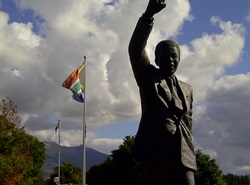
Rhino will soon to be called a "Nhono".
A "crash of Rhinoceros" is an aptly termed collective noun which has more meaning to the state of all Rhino species left in the world than its actual grammatical intention.
There is great concern from the South African Tourism sector along with all Citizens of the country, witnessing one of South Africa's Big 5 wild animals rapidly being decimated by poachers at an alarming and catastrophic rate supplying Rhino horn to Far East markets mainly Vietnam and of major moral concern in the trade, fellow to South Africa in the BRICS group of Nations, China.
It is estimated that 80% of the existing wild Rhino populations occur in Southern Africa with large proportions of the figures emanating from the World renown Kruger National Park and the Madikwe Reserve region of the North West Province where only this week saw the gruesome massacre of 10 adult Rhino, bringing annual totals of deaths to record amounts of over 530 gruesome Rhino deaths Country-wide.
Local poaching syndicates are well organised and in some circumstances highly trained with evidence implicating Veterinarians, Professional hunters and even Conservation Authorities, along with the less sophisticated but as harmful cross border raiding poachers from Mozambique and Zimbabwe. They are all driven by greed as Rhino Horn can fetch up to $65 000per/Kg on the black market and with many arrests but with more bail payments or cases being thrown out of the courts than convictions and with no steadfast plan of action, the Rhinoceros population is under extreme threat.
Rhino Horn in the Far East and Asia is valued in many ludicrous and mythical manners including status and remedy to various ailments even though it has been proven scientifically with Pharmaceutical studies commissioned by the WWF, performed by Hoffman-La Roche and backed up in later years by the Zoological Society of London that Rhino horn which has a makeup of Keratin similar to finger nails or hair, has absolutely no medicinal values. When the Studies were first complete in 1983 the Black Rhino population was at 15 000 and even with hard evidence, in 1993 the Black Rhino numbered 2300.
This is not a stand alone problem for South Africa. Irrespective of which country you live in around our globe, if you wish to be able to view this wonderful creature in the wild and more importantly if you wish to have your children and generations after that enjoying Rhinoceros in their natural habitat, then the citizens of the whole world need to stand up and let voices and actions be heard and felt too. It is most interesting to hear people talking about travel and holidays to Vietnam but do you ever hear them remarking about the Rhino they have seen there? No, because they have already murdered their own population and it’s estimated that only 6 Vietnamese Javan specie Rhino’s still exist.
For more infomation and ways for you to help stop the slaughter and prevent the complete extinction of the worlds Rhino population view the following websites.
www.savingrhinos.org and www.rhinoconservation.org
There is great concern from the South African Tourism sector along with all Citizens of the country, witnessing one of South Africa's Big 5 wild animals rapidly being decimated by poachers at an alarming and catastrophic rate supplying Rhino horn to Far East markets mainly Vietnam and of major moral concern in the trade, fellow to South Africa in the BRICS group of Nations, China.
It is estimated that 80% of the existing wild Rhino populations occur in Southern Africa with large proportions of the figures emanating from the World renown Kruger National Park and the Madikwe Reserve region of the North West Province where only this week saw the gruesome massacre of 10 adult Rhino, bringing annual totals of deaths to record amounts of over 530 gruesome Rhino deaths Country-wide.
Local poaching syndicates are well organised and in some circumstances highly trained with evidence implicating Veterinarians, Professional hunters and even Conservation Authorities, along with the less sophisticated but as harmful cross border raiding poachers from Mozambique and Zimbabwe. They are all driven by greed as Rhino Horn can fetch up to $65 000per/Kg on the black market and with many arrests but with more bail payments or cases being thrown out of the courts than convictions and with no steadfast plan of action, the Rhinoceros population is under extreme threat.
Rhino Horn in the Far East and Asia is valued in many ludicrous and mythical manners including status and remedy to various ailments even though it has been proven scientifically with Pharmaceutical studies commissioned by the WWF, performed by Hoffman-La Roche and backed up in later years by the Zoological Society of London that Rhino horn which has a makeup of Keratin similar to finger nails or hair, has absolutely no medicinal values. When the Studies were first complete in 1983 the Black Rhino population was at 15 000 and even with hard evidence, in 1993 the Black Rhino numbered 2300.
This is not a stand alone problem for South Africa. Irrespective of which country you live in around our globe, if you wish to be able to view this wonderful creature in the wild and more importantly if you wish to have your children and generations after that enjoying Rhinoceros in their natural habitat, then the citizens of the whole world need to stand up and let voices and actions be heard and felt too. It is most interesting to hear people talking about travel and holidays to Vietnam but do you ever hear them remarking about the Rhino they have seen there? No, because they have already murdered their own population and it’s estimated that only 6 Vietnamese Javan specie Rhino’s still exist.
For more infomation and ways for you to help stop the slaughter and prevent the complete extinction of the worlds Rhino population view the following websites.
www.savingrhinos.org and www.rhinoconservation.org




 RSS Feed
RSS Feed


